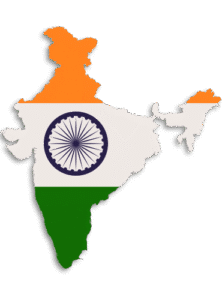Country Profile
India

India's economy is among the fastest-growing in the world, currently ranked 4th globally by nominal GDP and 3rd by purchasing power parity (PPP). It boasts a diverse economic structure, led by a dynamic services sector, a rapidly expanding industrial base, and a significant agricultural workforce. As of 2025, India continues its trajectory toward becoming a $5 trillion economy, driven by domestic consumption, infrastructure growth, global IT leadership, and increasing trade influence across Asia and beyond.
India is the seventh-largest country in the world by land area and the most populous democracy, located in South Asia and bordered by Pakistan, China, Nepal, Bhutan, Bangladesh, and Myanmar. It spans diverse landscapes, from the Himalayan mountain range in the north to coastal plains in the south, and shares extensive maritime boundaries with the Indian Ocean, Arabian Sea, and Bay of Bengal.
GDP Per Capita
Approximately $2,878 USD, reflecting steady growth aligned with rising national income
Learn More$4.19 trillion (IMF estimate) the end of 2025 —a reflection of sustained economic growth
Learn MoreIndia's population is estimated to be around 1.46 billion in 2025, making it the most populous country in the world.
Learn MoreIndia's arable land area of 1,597,000 km² (394.6 million acres) is the second largest in the world, after the United States.
Learn More| Metric | Value |
|---|---|
| Total Import (India ← Bangladesh) | US $11.07 billion (FY 23–24) |
| Total Export (Bangladesh) | US $1.84 billion (FY 23–24) |
| Total Import (Global) | US $915 billion (India’s total imports FY 24–25) |
| Total Export (Global) | US $820.9 billion (exports, goods + services FY 24–25) |
| Public Debt (Domestic) | 56.1 % of GDP (end-FY 25–26; central gov’t) |
| Unemployment Rate (Overall) | 5.1 % in April 2025 (first monthly job survey) |
| Youth Unemployment | 16 % (Jan 2024 estimate) |
| Inflation Rate (CPI) | 2.5 % in June 2025 (lowest in ~6 years) |
| Labor Force | 610 million workers (2025 estimate) |
| Investment to GDP Ratio | Estimated ~32 % (approx, given capital expenditure target of 3.1 % of GDP) |
| GDP by Sector Growth (Real GVA) | Agriculture: ~3.8 %, Industry: ~6.2 %, Services: ~7.2 % (FY 24–25) |
| GDP Growth Rate (Real) | 6.4 % real GDP growth in FY 24–25, with stronger Q4 pushing FY to 6.5 % overall |
India's textile exports are projected to reach US $65 billion by FY 2025‑26, with the domestic textile market targeting US $350 billion by 2030 under the "Fibre to Fashion" vision elearn.legacyias.com+4Wikipedia+4The Times of India+4.
The Production Linked Incentive (PLI) Scheme has driven ₹7,343 crore (~US $900 million) in investments into the textile sector, catalyzing export growth and strengthening global competitiveness Wikipedia+3elearn.legacyias.com+3The Economic Times+3.
Non-petroleum, non‑jewellery exports surged ~9.1 % YoY, with engineering goods (+9.9 %), electronics (+28.6 %), pharma (+6.4 %), and textiles (+7.6 %) leading the charge Business Standard.
Services exports rose 11.6 % in the first nine months of FY 25, bringing total services receipts to US $131.3 billion Business Standard.
PM-MITRA Textile Parks are operational across seven states, offering integrated “farm-to-fashion” facilities and reducing logistics costs for manufacturers Wikipedia+5Wikipedia+5textileworld.com+5.
The National Technical Textiles Mission (NTTM) supports innovation across fiber, fabric, and fashion segments via 168 R&D projects and skill development under a ₹1,480 crore allocation indiaseatradenews.com+3IAS Google+3elearn.legacyias.com+3.
India attracted US $4.47 billion in textile FDI from 2000 to 2024, boosted by schemes like PLI and PM-MITRA parks IAS Google+11indiaseatradenews.com+11elearn.legacyias.com+11.
The broader PLI initiative, valued at US $28 billion across 13 sectors, has underperformed, disbursing only US $1.7 billion by early 2025; revisions are being considered to enhance its impact Wikipedia.
India’s East Coast Economic Corridor (ECEC) and Visakhapatnam–Chennai Industrial Corridor (VCIC) are promoting coastal industrialization and regional connectivity, aligned with Sagar Mala and Act East strategies Wikipedia+1Wikipedia+1.
Aurangabad Industrial City (AURIC) on the Delhi–Mumbai corridor is expanding by 10,000 acres and highlighted as pivotal for India’s goal of becoming a $30 trillion economy by 2047 The Times of India.
A nationwide strike on July 9, 2025—for protesting privatization and labor reforms—disrupted key sectors like manufacturing and transport, reflecting rising social friction amid economic policy shifts AP News.
Indian textile exports stand to benefit from US tariffs on Bangladesh (35% on imports), making India more attractive to US buyers, though structural challenges such as labor shortages and cost pressures persist Reuters+1Indiatimes+1.